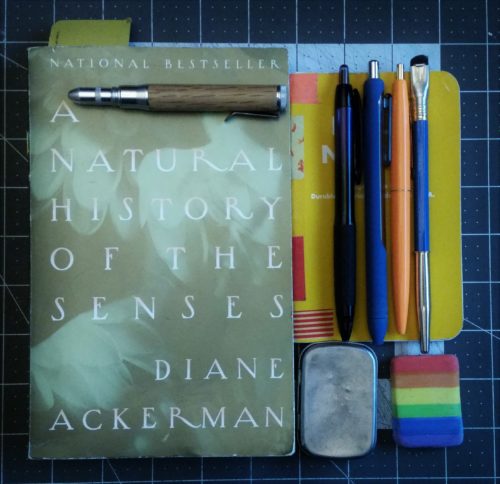I first read A Natural HIstory of the Senses (ANHotS) way back in 1992, only 2 short years after it’s release, and when I was the impressionable age of 16. It blew my fragile little mind. I’d never read anything quite like this book, and I’d certainly never read much about the human senses, particularly not in the way Ackerman writes about them. This is one of the few books that after reading a few passages I was moved to purchase my own copy. I read that copy repeatedly while I was still in high school and took it with me to college, where I would read and reread passages when I felt that they applied to my life. I shared it with friends over coffee, and discussed it at length. Not only did this book move me, it influenced my thinking over the years. After college I stopped referring to it as often as I once had and in the intervening years I’ve had the pleasure to explore many of her concepts. But after nearly 20 years of not looking at the book, I purchased a new copy (it’s wicked cheap on Amazon) and when I pulled the quote for my paper, the text fell flat to me. It simply didn’t resonate in the same way it once did. It came up during a recent discussion and I felt it was time to give it another once over, now that I’m outside of the rigors of academia I feel like I can give the text a slightly more fair reading. 
One of the frequent criticisms that I’ve read concerning Ackerman’s writing is that it’s very flowery. I think this is a very fair assessment, Ackerman is a poet, and her prose does lean toward the violet spectrum. That said, her style of writing, though flowery, is easy to read and flows in a beautiful manner. Part of the reason this book resonated so deeply with me is that a friend of mine and I read it aloud to one another. This book would likely be one that I could attend to on tape or via audible. Ackerman’s prose in inherently readable.
Since publication in 1990, some of Ackerman’s thoughts and thinking have been disproven- through science and experience. In the section I was utilizing for my paper in school, one of the ideas had been disproven (don’t ask me to remember which/what it was, I’ve been wracking my brain, only to not remember.) I suspect this is why, when I was deep in the academic world, the book was disappointing and resonated with me less than it had in the past. Though some of what she surmised has been disproven much of what she guessed at or thought, has been proven. There is a great deal of truth in these pages. I think this is what caused me to enjoy the book less as I read it when in school.
Now that I’ve been out of school, and I’m not in the “peer reviewed only” article mode of thought, I’ve been able to delve deeper into the book and actually reread it from start to finish (As of this posting I’ve a little more than 75% through the book.) I find I’m rediscovering what it is I enjoyed about this book. It’s that nerdy in depth analysis of a topic of interest in a completely sincere manner. Ackerman delves deep into her topics, writes in violet prose, and yet the book is delightfully readable. One of the reasons I adored this book at 16 is that a friend of mine and I read passages of it aloud to one another. Ackerman’s writing begs to be read aloud. (Note to self: Check to see if the library has an audio copy of this book.) Yes the writing is flowery, and on occasion approaching too much, but at the same time, how deep on a topic can one go when really truly passionate about it?
Next week I’ll be looking at Wabi-Sabi, a slim little volume that is easily read in a few hours, but will leave you thinking for days, months, and perhaps years. I think the ideas in WAbi-Sabi particularly relate to the use of an art journal. But I’ll get into that next Sunday.
Yes, all links in this post are Amazon Affiliate links. I get a few pieces of coin should you chose to purchase the book through these links. No it is not a lot of coins. Every penny helps to buy more books, art supplies, and yes to keep this blog up and running.